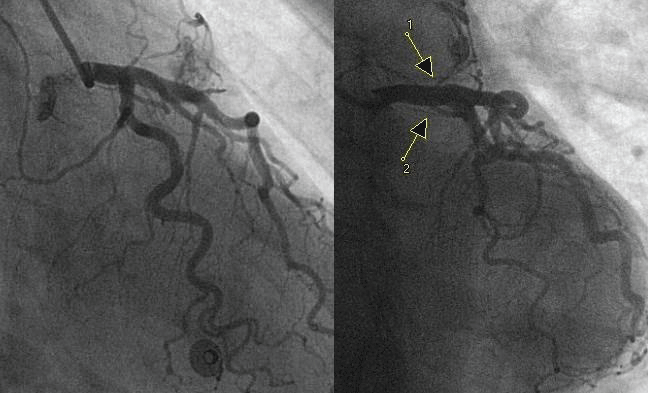International Journal of Clinical Cardiology
Symptomatic Main Coronary Artery Fistula with Stress/Rest Myocardial Perfusion SPET Ischemia
Ramirez-Moreno A* and JR. Siles-Rubio
Cardiology Department, Hospiten Estepona, Estepona, Malaga, Spain
*Corresponding author: A. Ramirez-Moreno MD, PhD, Cardiology Department, Hospiten Estepona, CN 340, Km 162, 29680 Estepona, Malaga, Spain, E-mail: cardio.ramirez@yahoo.es
Int J Clin Cardiol, IJCC-2-053, (Volume 2, Issue 5), Case Report; ISSN: 2378-2951
Received: July 06, 2015 | Accepted: September 18, 2015 | Published: September 21, 2015
Citation: Ramirez-Moreno A, Siles-Rubio JR (2015) Symptomatic Main Coronary Artery Fistula with Stress/Rest Myocardial Perfusion SPET Ischemia. Int J Clin Cardiol 2:053. 10.23937/2378-2951/1410053
Copyright: © 2015 Ramirez-Moreno A, et al. This is an open-access article distributed under the terms of the Creative Commons Attribution License, which permits unrestricted use, distribution, and reproduction in any medium, provided the original author and source are credited.
Introduction
Recently reports of congenital coronary-pulmonary fistula have been increasing with the wide-spread use of coronary angiography. However, the cause of the angina sometimes seen as a chief complaint in coronary fistula has not been well demonstrated although it has been suggested that coronary steal phenomenon accounts for it.
Case Report
We report a case of 65-year-old woman who presented sporadic exercise chest pain episodes. The rest ECG, cardiac ultrasound were normal, exercise test shows nonspecific repolarization ECG changes, myocardial Stress/Rest Tc-99m MIBI SPET disclosed a reversible defect in the medial and distal portions of the anterior wall and the apex.
Coronary angiogram showed a main left coronary to pulmonary artery fistula, with a double source from main coronary artery, a plexiform vascular formation opens through a collector into the pulmonary artery. Arteriosclerotic coronary disease was discarded.
Right catheterization results PA: 38/21/26 mmHg. RV: 35/12 mmHg. RA: 9 mmHg. Normal right ventricular angiogram with no evidence of ventricular septal defect neither persistent arteriosus ductus. QP/QS: 1.2:1
Patient received medical treatment with calcium blockers, and at the 12- month follow-up no changes of clinical symptoms showed.
Discussion
This case has special interest because the casual findings of unusual located coronary fistula from main coronary artery to main pulmonary artery manifested as effort angina, and with functional ischemia demonstration even despite significant I-D shunt.
It is generally agreed that coronary artery fistula are embryogenic anomalies due to persistence of primitive anastomosis between the epicardial vessels and the intramyocardial sinusoid circulation. The coronary to extracardiac arterial or venous connections result from the persistence of a vascular communication within the mediastinal mesoderm [1]. The coronary vessel involved is usually dilated in the section proximal to the fistula, sometimes to the point of forming an arteriovenous aneurysm. The flow through the fistula may exceed that to the myocardium, giving rise to a left-to-right shunt. This is also encouraged by the low resistance of the fistula, which results in volumetric overloading of the right ventricle. In some patients, this type of shunt lowers the intracoronary diastolic perfusion pressure and causes true "coronary steal" ischemia [2].
Fifty percent of coronary artery fistulas remain asymptomatic until adulthood; the remainder is accompanied by volumetric overloading symptoms, endocarditis, angina, and arrhythmia due to compression of the heart [3].
A continuous mesocardia murmur is a very common sign, however it was not detected in this case. It resembles that evoked by patent arteriosus ductus. The ECG is rarely positive and in any event nonspecific. Chest roentgenograms can only occasionally reveal the signs of the pulmonary excessive flow, especially in the case of a substantial left-to-right shunt.
The best aids to diagnosis are mono- and bi- dimensional echocardiography, particularly transesophageal echocardiography, echo-color Doppler, and cardiac catheterization. Perfusive Stress/Rest myocardial scintigraphy is employed to diagnose myocardial ischemia, also as a consequence of coronary fistula, where it can be useful to assess the hemodynamic significance of the flow through a fistula.
Our patient presented recurrent angina and a flow through a fistula between the left main coronary artery and the main pulmonary artery, as shown by coronary angiography. The left coronary artery district was marked by a reversible stress-induced defect. Left main coronary artery diameter was normal. Because the coronary artery was free from stenosis, the myocardial ischemia was thought to be due to a flow steal between the high-pressure coronary system and the low-pressure pulmonary arterial system. In addition, the pressure gradient is higher during effort. Our finding demonstrated the hemodynamic importance of the shunt through the fistula when the patient performed a high working load stress test (Figure 1)
This examination must be performed to demonstrate the functional importance of the coronary artery fistula between the coronary artery and the pulmonary artery and also to evaluate the concomitant coronary atherosclerosis. This finding is of fundamental assistance in planning the management of the vascular malformation.
Treatment of coronary fistula is controversial, previous literature suggested closing fistula by device, coil or surgical ligation if patient had coronary artery dilatation, continuous murmur, significant left-to-right shunt or recurrent symptoms. However, our case had satisfactory evolution at long follow up just with medical treatment.
References
-
Angelini P (1989) Normal and anomalous coronary arteries: definitions and classification. Am Heart J 117: 418-434.
-
Levin DC, Fellows KE, Abrams HL (1978) Hemodynamically significant primary anomalies of the coronary arteries. Angiographic aspects. Circulation 58: 25-34.
-
Engel HJ, Torres C, Page L Jr (1975) Major variations in anatomical origin of the coronary arteries: Angiographic observations in 4250 patients without associated congenital heart disease. Cathet Cardiovasc Diagn 1: 157-169.






